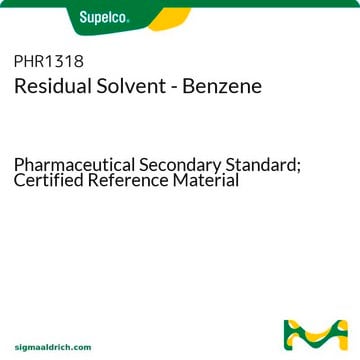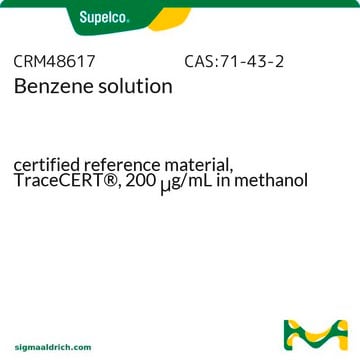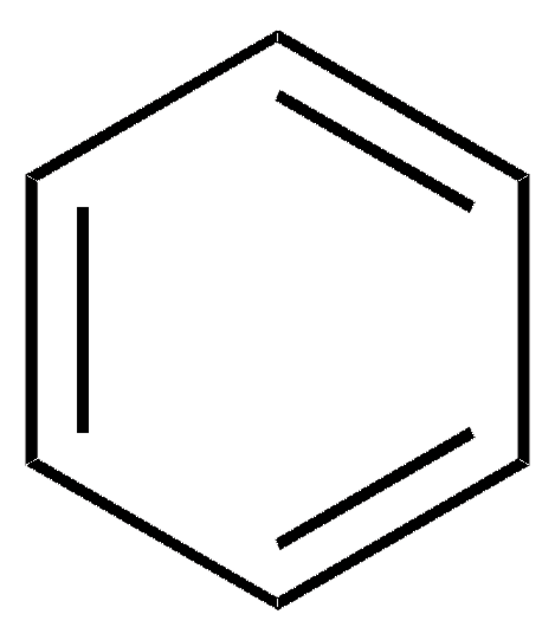PHR1310
Benceno
Pharmaceutical Secondary Standard; Certified Reference Material
About This Item
Productos recomendados
grado
certified reference material
pharmaceutical secondary standard
Nivel de calidad
Agency
traceable to NIST 3000
traceable to USP 1601146
densidad de vapor
2.77 (vs air)
presión de vapor
166 mmHg ( 37.7 °C)
74.6 mmHg ( 20 °C)
CofA
current certificate can be downloaded
temp. de autoignición
1043 °F
lim. expl.
8 %
técnicas
HPLC: suitable
gas chromatography (GC): suitable
índice de refracción
n20/D 1.501 (lit.)
bp
80 °C (lit.)
mp
5.5 °C (lit.)
densidad
0.874 g/mL at 25 °C (lit.)
aplicaciones
pharmaceutical (small molecule)
Formato
neat
temp. de almacenamiento
2-30°C
cadena SMILES
c1ccccc1
InChI
1S/C6H6/c1-2-4-6-5-3-1/h1-6H
Clave InChI
UHOVQNZJYSORNB-UHFFFAOYSA-N
¿Está buscando productos similares? Visita Guía de comparación de productos
Descripción general
Aplicación
Nota de análisis
Otras notas
Nota al pie de página
Productos recomendados
Palabra de señalización
Danger
Frases de peligro
Consejos de prudencia
Clasificaciones de peligro
Aquatic Chronic 3 - Asp. Tox. 1 - Carc. 1A - Eye Irrit. 2 - Flam. Liq. 2 - Muta. 1B - Skin Irrit. 2 - STOT RE 1
Órganos de actuación
Blood
Código de clase de almacenamiento
3 - Flammable liquids
Clase de riesgo para el agua (WGK)
WGK 3
Punto de inflamabilidad (°F)
12.2 °F
Punto de inflamabilidad (°C)
-11 °C
Elija entre una de las versiones más recientes:
Certificados de análisis (COA)
Lo sentimos, en este momento no disponemos de COAs para este producto en línea.
Si necesita más asistencia, póngase en contacto con Atención al cliente
¿Ya tiene este producto?
Encuentre la documentación para los productos que ha comprado recientemente en la Biblioteca de documentos.
Los clientes también vieron
Protocolos
ASTM D6526: GC Analysis of Impurities in Toluene on SLB®-IL100, 60 m Column
HPLC Analysis of Benzene and Deuterated Benzene on Ascentis® Express C18
GC Analysis of Xylene Isomers on SLB®-IL60
-Xylene; Nonane; Decane; 1,2,4-Trimethylbenzene; Butylcyclohexane; Naphthalene
Nuestro equipo de científicos tiene experiencia en todas las áreas de investigación: Ciencias de la vida, Ciencia de los materiales, Síntesis química, Cromatografía, Analítica y muchas otras.
Póngase en contacto con el Servicio técnico









